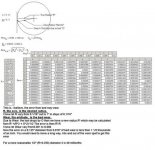Decided to measure vertical drop at the cross-slide/toolpost.
.004 consistently for about a foot in front of the chuck, and then rises to O quickly and remains 0 consistently for the next couple feet to the end of the 4-1/2' bed; measured with a drop indicator on the compound and the Noga on the tailstock as the carriage pushes it to the far end of the bed. There is a very light ridge on the tailstock v-way and base, but it has been shimmed and aligned with a long test bar to the headstock.
Most of my work is 2-3 feet from the chuck in the steady and my tailstock is aligned for that area of the bed.
Mathematically, what would I expect as a variation in diameter of the workpiece from .004 of drop?
.004 consistently for about a foot in front of the chuck, and then rises to O quickly and remains 0 consistently for the next couple feet to the end of the 4-1/2' bed; measured with a drop indicator on the compound and the Noga on the tailstock as the carriage pushes it to the far end of the bed. There is a very light ridge on the tailstock v-way and base, but it has been shimmed and aligned with a long test bar to the headstock.
Most of my work is 2-3 feet from the chuck in the steady and my tailstock is aligned for that area of the bed.
Mathematically, what would I expect as a variation in diameter of the workpiece from .004 of drop?








